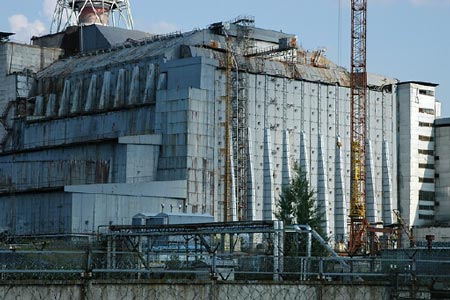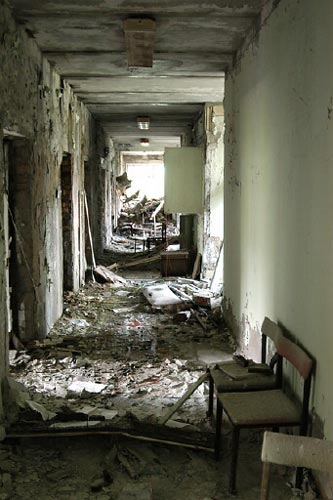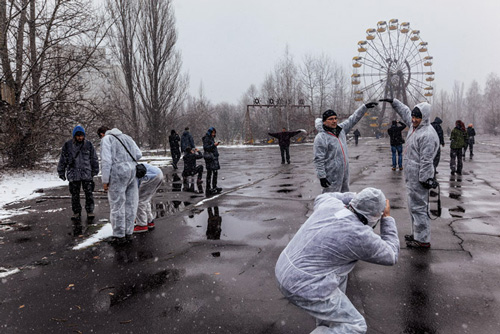The Chernobyl Site Over 30 Years Later

The Sarcophagus of Unit 4
In 1986, the Soviet authorities built a structure called a sarcophagus within a few months after dumping thousands of tons of materials from helicopters onto the damaged Unit 4. The sarcophagus contains most of the 190 tons of fuel left in the melted reactor core. Hastily built and fragile, the sarcophagus underwent reinforcement work to reduce the risk of collapse or leakage of radioactive materials.
© Petr Pavlicek/IAEA
On December 15, 2000, the Ukrainian government, in accordance with a commitment made in 1995, permanently shut down the last operating reactor at the site. This event marked the end of the operation of RBMK reactors in Ukraine. As of that date, 13 reactors of this type were still in operation—on two sites in Russia and one in Lithuania.
Despite the final shutdown, large amounts of radioactive materials remained on site. A dismantling program was defined and implemented, with financial support from the international community.

Pripyat: An Abandoned City
Debris and plaster are all that remain of the city polyclinic in Pripyat, 3 km from Chernobyl. The buildings were left intact, but time and looters scavenging furniture and equipment have taken their toll.
© Petr Pavlicek/IAEA
Ukrainian authorities declared a dead zone with a 29 km radius (about half the size of a French department), now filled with ghost towns and the desolation typical of ruins and abandoned remnants. The most well-known is Pripyat, located about 2 km from the disaster, evacuated in haste, leaving behind its 50,000 residents.
Decontamination efforts made the reactor complex safe enough for workers and visitors. Most of the cleaned areas were cleared with bulldozers that scraped away over a meter of contaminated soil.
Over the years, radiation risk in the affected zones has significantly decreased due to natural decay and mitigation measures. Most contaminated areas are now decontaminated enough to support life and economic activity. However, in the exclusion zone and a few other places, land-use restrictions will remain for a long time.

The Exclusion Zone: An Abandoned Territory
Chernobyl’s exclusion zone—more than 2,600 square kilometers around the destroyed reactor—has returned to the wild. This pack of dogs feeds on leftovers brought by cleanup workers and the few remaining residents. Wild animals like boars and deer thrive there. Ironically, in the absence of humans, the exclusion zone has taken on the appearance of a natural park.
© Photograph by Gerd Ludwig/NGM
As for the sarcophagus, built in 1986 in just six months under difficult conditions to contain the remains of the damaged reactor, there is still a risk of collapse due to the lack of long-term structural diagnostics. Such a collapse could release radioactive dust into the immediate environment.
However, if this happened, it would not be a « second Chernobyl » as sometimes claimed. There would be no fire or explosion. The dust would settle in the nearby area and would be far less radioactive than in 1986 due to the complete decay over 30 years of volatile and short-lived elements like iodine-131, which were especially harmful during the reactor explosion.
Major work was undertaken to prevent further deterioration of the sarcophagus. The program received significant funding from the European Union. Construction of a large arch above the sarcophagus began in 2010 and was completed in late November 2016. Long-term plans include dismantling the sarcophagus to recover the buried highly radioactive materials.
The spent fuel from the three shutdown reactors is currently stored in pools next to those reactors. There are no plans to reprocess the spent fuel, which could have allowed safer storage. Instead, a facility for dry storage was proposed. In addition, a storage and treatment center for radioactive waste from the Chernobyl plant and surrounding area was inaugurated in 2008. Part of the center, built with assistance from the European Commission, was designed to accommodate 75,000 m³ of radioactive waste.

2014: Nuclear Tourism in Pripyat
This amusement park was scheduled to open on May 1, 1986, but the plant exploded five days earlier. It has become a new kind of tourist attraction.
© Gerd Ludwig : National Geographic Magazine
Thanks to time and decontamination efforts, a 2014 article in *National Geographic Magazine* reported on a rise in nuclear tourism. After wildlife reclaimed the nearly uninhabited zone, a new kind of visitor emerged. Dressed in white coveralls, tourists take selfies in the amusement park of the ghost town of Pripyat. They do not wear masks but avoid picking mushrooms. In 2018, more than 70,000 people visited the city.
What lesson can we draw 30 years after the accident? Could another Chernobyl happen? It should be remembered that the accident would not have occurred if the operators had not disabled safety systems. By 2016, the probability of major accidents had become extremely low, though safety authorities still do not rule them out entirely. The nuclear industry focuses instead on minimizing the consequences—especially avoiding major radioactive releases and the trauma of evacuating entire populations.
2022: RUSSIA INVADES UKRAINE
On February 24, 2022, Russia invaded Ukraine. Russian troops from Belarus occupied the plant (tourism in Pripyat was no longer an option). Ukrainian staff, under duress and in difficult conditions, continued to ensure the site’s safety. One concern was the large spent fuel storage pool, which contains assemblies from the plant’s three non-damaged units, the last of which shut down in 2000. About 22,000 assemblies are stored there. After 22 years, their heat output has significantly decreased. If cooling water circulation were interrupted, the pool’s temperature would reach between 65 and 70°C, eliminating the risk of boiling. Meanwhile, work near the large arch was suspended. In the absence of fighting at the site, there was no radioactive release risk by late March 2022. Around the same time, Russian troops withdrew from the Kyiv region, including Chernobyl.
March 16, 2022: Safety and security of nuclear facilities in Ukraine: an update on issues since Russian forces took control of the Chernobyl and Zaporizhzhia nuclear plants (SFEN video)
February 14, 2025: A Strike Damages the Reactor Containment Structure
On Friday, February 14, Ukrainian President Volodymyr Zelensky accused Russia of damaging the metal confinement arch of the Chernobyl nuclear plant with an explosive drone. The Kremlin’s spokesperson, Dmitry Peskov, responded that the Russian military does not target nuclear facilities: “There can be no talk of strikes on any nuclear infrastructure (…) Russian soldiers do not do that.”

The Strike Damaged the Reactor Confinement Structure
The metal structure, inaugurated in 2019, covers the sarcophagus and the radioactive debris inside. The strike occurred around 1:50 a.m., according to the International Atomic Energy Agency (IAEA). Personnel on-site responded a few minutes later. According to the IAEA, « radiation levels inside and outside remained normal and stable. »
© DR
The damage was fortunately minimal. The incident occurred amid intense diplomatic activity surrounding the war in Ukraine. U.S. President Donald Trump had broken the status quo and the West’s isolation of Vladimir Putin by announcing the start of peace talks. This initiative raised fears that Washington might abandon Ukraine and weaken its negotiating position.
Other articles on the subject « Chernobyl accident »
Chernobyl Circumstances
An explosion followed by a graphite fire In 1986 the Ukrainian Chernobyl plant had 4 RBMK reactor[...]
Chernobyl Liquidators
A heavy toll paid by firefighters and liquidators: The magnitude of the disaster took the Soviet [...]
Radioactive Releases
Radioactive releases and contaminations at Chernobyl The explosion of the reactor led to the disp[...]
Chernobyl Plume
A deep mark in the french collective unconscious « The Chernobyl cloud has stopped at the french [...]
Chernobyl Exclusion Zone
A no man’s land turned into a natural reserve ? On April 27th, 1986, one day after the expl[...]
Chernobyl Health Effects
Chernobyl: A toll still impossible to quantify It is difficult to reach an approached assessment [...]
Chernobyl Iodine 131
A dangerous radioelement during the first weeks Iodine-131 is the most feared fission product whe[...]
Chernobyl Caesium-137
The accident long term legacy More than twenty years after the Chernobyl accident, attention focu[...]